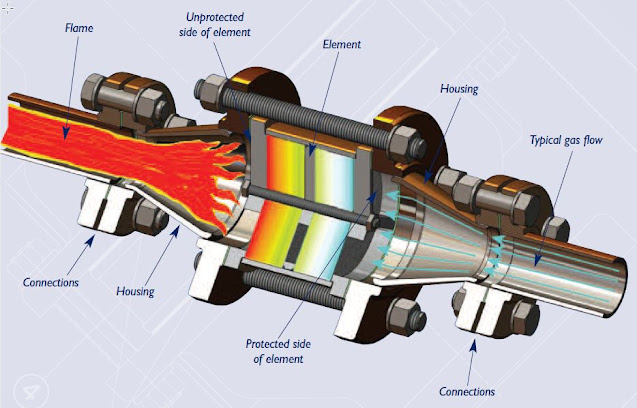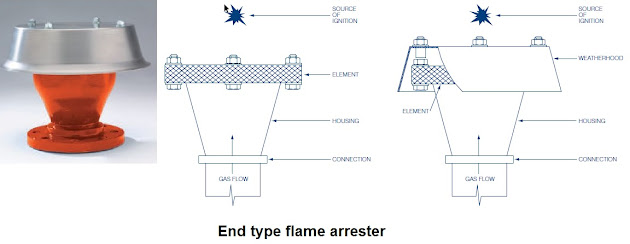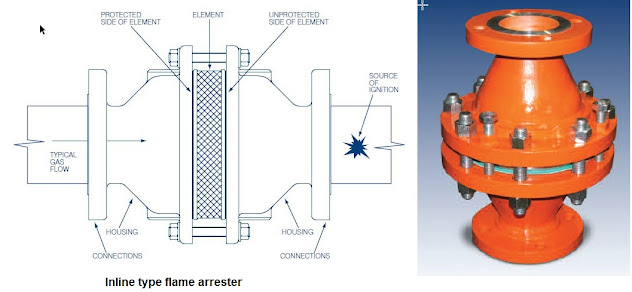Flame arrester: A flame arrester is a safety device whose principal purpose is to prevent a flame entering or leaving a pipe or vessel or to prevent it traveling further down a pipe. In many cases it is used in conjunction with other components to create a safety system. Failure to stop a flame can result in catastrophic damage to equipment, loss of production, injury to people and even loss of life and potentially large litigation costs.
There are different types of flame arrester, each of which is designed to handle certain conditions. It is essential that the flame arrester is correctly specified to ensure that a flame is extinguished (or properly contained) and that an explosion is prevented from propagating through the equipment.
The first step in specifying a flame arrester is to determine the location of the potential ignition source. Only when this has been established can one start to understand what is to be protected and how.
Flame arrester is a device fitted to the opening of an enclosure or to the connecting pipe work in a system of enclosures and which permits gases or vapours to flow under normal operating conditions but prevents the transmission of a flame should an ignition take place. In this guide, consideration is limited to flame arresters for use where the flame burns in air (and not in oxygen where there are special problems). Furthermore, the guide is restricted to passive flame arresting devices with no moving parts.
Why we use flame arrester
One of the greatest dangers involved with the transport or storage of flammable liquids or gases is that ignition of the flammable vapour may occur, resulting in fire or worse, an explosion. This guide sets out to introduce the subject of flame arresters, and the principles and concepts behind their specification and use.
Whenever a flammable gas or vapour is mixed with air/oxygen, there is the potential for an explosion. Accidental ignition of the flammable mixture will result in a flame that will travel through the unburnt mixture until the fuel is consumed by the reaction. In an enclosed space, such as a vessel or a pipe, the significant temperature increase of the mixture caused by the combustion process will lead to a rapid increase in the volume of the gas mixture. The resulting increase in pressure will induce turbulent effects which will further accelerate the flame front.
Conditions where fame arrester found
Unconfined Deflagration:– An unconfined deflagration occurs when there is an ignition of a flammable atmosphere outside a container or other process equipment. For example, a breathing or ventilation outlet from a tank storing gasoline may produce an unconfined cloud of flammable vapour in its immediate vicinity.
Ignition sources such as a lit cigarette, a static electrical discharge or a lightning strike could ignite this vapour cloud and the resulting flame front may enter the tank through the outlet.
Confined Deflagration:– Where a flammable mixture in a pipeline is ignited, the flame front will initially travel along the pipe at subsonic velocities in what is known as a confined deflagration. Typically this could occur in industrial or process plant.
For example, many coal mines generate flammable and poisonous methane gas below ground which is pumped to the surface along a pipe and then burnt in a boiler for heating purposes. Problems with the boiler or the pumping system could ignite the pipe contents and the flame could travel back down the pipe resulting in an explosion below ground.
Detonation:-A detonation occurs where a flame travels along a pipe, usually at supersonic velocities and is combined with a shock wave. Typically this occurs as a result of turbulence-induced flame acceleration caused by roughness in the pipe walls or interruptions such as bends, valves or changes in section of the pipe.
It can also occur simply by allowing the flame to continue to accelerate along a pipe for a sufficient distance. A shock wave is characterized by a step change in pressure and density through which the flame velocity changes from being subsonic to supersonic.
Types of flame arrester
End-of-line flame arresters:-End-of-line (EOL) flame arresters are fitted to the end of a pipe line or exit to a vessel to prevent flames from entering, and not, as is sometimes believed, to prevent the flame exiting the pipe or vessel. Without a weather-hood, they may be mounted in almost any orientation, but inverted mounting is not recommended as this increases the risk of heat being trapped thus causing a flash back.
With a weather-hood incorporated, they should be fitted in a conventional vertical orientation and be used outside exposed to rain and snow.
In-line flame arresters:-In-line flame arresters are fitted in piping systems to protect downstream equipment. The layout shown below is typical although it is also possible that the source of ignition could cause the flame to travel with the gas flow. If the flame could come from either direction then a bi-directional flame arrester is required.
In-line flame arresters can be either deflagration or detonation arresters depending on the conditions under which they are to be used. Pipe orientation is usually not a problem unless liquid is entrained in the gas flow and would tend to collect in the arrester. In such situations, eccentric flame arrester housing may be fitted to allow collection and drainage of the liquid.
Pre-volume flame arresters
These are so called because they are designed to protect systems in which a flame may start within a container whose cross sectional area is somewhat larger than the flame arrester element or the vent pipe and the desire is to prevent the flame leaving the container.
They may be simply an element, an end-of-line arrester or an in-line arrester. Extreme care must be taken when considering such a situation as it is not possible to predict the conditions that the flame arrester will have to handle because the volume of hot gases passing through the arrester will exceed the volumes produced for conventional in-line arrester flame testing.
Although the conditions will tend to produce a confined deflagration it is possible that an arrester that has been satisfactorily tested under confined deflagration arrester conditions laid down in a product standard will not be satisfactory. Therefore, the only solution to ensure total confidence in the product specified is to test it under actual or simulated operational conditions.
Liquid product and hydraulic flame arresters Liquid product flame arresters trap some of the liquid flowing in a pipe so that the gases may bubble through it but any flame is extinguished. Hydraulic arresters contain water whose level is automatically maintained. Similarly gases may bubble through it but any flame would be extinguished. This technique is particularly suited to a dirty gas flow with particulate matter entrained within it.
Flame arrester in use
For the majority of the time that a flame arrester is in place it will be required to permit the process gas to flow and will be expected to extinguish flames on extremely rare occasions. A key characteristic of a flame arrester is the pressure drop or degree of obstruction to process flow due to its method of construction. This can lead to problems and it is essential that the design and sizing of the flame arrester are matched to the process flow rates and pressure drop permitted in the system whilst ensuring that adequate protection is provided against accidental ignition.
Having defined where the possible source or sources of ignition may occur and exactly what is to be protected, then the objective is to place the flame arrester as close as possible to the ignition source. If a flame is allowed to proceed down a pipe then, in general, it will accelerate because of pressure build up resulting from the increased temperature and volume of burnt products and be progressively more difficult to stop.
Ultimately a deflagration may undergo transition to a detonation and therefore become significantly more destructive to equipment. Where there is more than one source of ignition then it may be appropriate to install more than one flame arrester.
If the flammable mixture continues to flow after flame transmission has been prevented the flame may stabilise on or near the element and continue to burn. This will cause the element to continue to heat up and can lead to flame transmission. Specially developed and tested products are required for such eventualities and often a flame sensor is linked to a gas supply cut off system to extinguish the flame soon after detection.
Construction of flame arrester
Typically a flame arrester comprises housing, an element and connection(s) to secure it to pipe work or equipment. The element is the device that quenches the flame and the majority of constructions used incorporate a form of “filter” that provides small apertures through which the process gas will flow but will prevent flame transmission. The flame front is broken down in the “filter” into smaller flamelets which are cooled by the large heat capacity of the element thus extinguishing the flame.
Materials used for the filter element include crimped metal ribbons, woven wire gauze, sintered materials and honey comb materials. Because of its construction, the element will cause a pressure drop or an obstruction to process flow. In order to mitigate this increased resistance to flow, the element area is usually larger than the cross sectional area of the pipe work. Larger elements also have a greater heat capacity.
The housing of the flame arrester can be integral to or separate from the element housing. In the latter case it is joined together with fastenings. The end connections are usually either flanged or screwed fittings to match the adjacent pipe work. Other types of flame arrester include devices which incorporate a small aperture that ensures the velocity of the gas being emitted exceeds the burning velocity of that gas and thus will not transmit the flame. Alternatively, the gas may be bubbled through a liquid or water in a manner that provides a liquid barrier to flame transmission.


